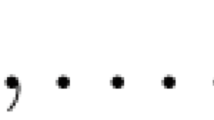Abstract
In this paper, we introduce a simple and original algorithm to compute a three-dimensional simplicial complex topologically equivalent to a 3D digital object V, according to the 26-adjacency. The use of this adjacency generates issues like auto-intersecting triangles that unnecessarily increase the dimensionality of the associated simplicial complex. To avoid these problems, we present an approach based on a modified Delaunay tetrahedralization of the digital object, that preserves its topological characteristics. Considering the resulting complex as an input in algebraic-topological format (fixing a ground ring for the coefficients), we develop propositions regardless of the adjacency considered. These potential applications are related to topological analysis like thinning, homology computation, topological characterization and control. Moreover, our technique is susceptible to be extended to higher dimensions.
Similar content being viewed by others
References
P. Alliez, D. Cohen-Steiner, M. Yvinec, and M. Desbrun, “Variational Tetrahedral Meshing,” ACM Trans. Graph. 24(3), 617 (2005).
C. Barber, D. Dobkin, and H. Huhdanpaa, “The Quickhull Algorithm for Convex Hulls,” ACM Trans. Mathem. Software 22(4), 469 (1996), http://www.qhull.org.
M. Bern, “Compatible Tetrahedrizations,” in Proceedings of the Ninth Annual Symposium on Computational Geometry (San Diego, California, USA, 1993), pp. 281–288.
J. Bernal, “Lexicographical Manipulations for Correctly Computing Regular Tetrahedralizations with Incremental Topological Flipping,” NISTIR 6335, (1999).
J. Bernal, “Regtet: A Program for Computing Regular Tetrahedralizations,” Lecture Notes in Computer Science 2073, 629 (2001), http://math.nist.gov/~JBernal/JBernal_Sft.html.
A. J. Cuadros-Vargas, L. G. Nonato, E. Tejada, and T. Ertl, “Generating Segmented Tetrahedral Meshes from Regular Volume Data for Simulation and Visualization Applications,” in Proceedings of CompIMAGE’06 (2006).
B. Cutler, J. Dorsey, and L. McMillan, “Simplification and Improvement of Tetrahedral Models for Simulation,” in Proceedings of the Eurographics Symposium on Geometry Processing 2004 (2004), pp. 93–102.
B. Delaunay, “Sur la sphère vide,” Izv. Akad. Nauk SSSR, Otdel. Matem. Estestv. Nauk 7, 793 (1934).
T. K. Dey, C. L. Bajaj, and K. Sugihara, “On Good Triangulations in Three Dimensions,” in Proceedings of the First ACM Symposium on Solid Modeling Foundations and CAD/CAM Applications, SMA’91 (1991), pp. 431–441.
H. Edelsbrunner and N. Shah, “Incremental Topological Flipping Works for Regular Triangulations,” Algorithmica 15(3), 223 (1996).
R. González-Díaz, B. Medrano, P. Real, and J. Sánchez-Peláez, “Algebraic Topological Analysis of Time-Sequences of Digital Images,” LNCS 3718, 208 (2005).
R. González-Díaz, B. Medrano, P. Real, and J. Sánchez-Peláez, “Reusing Integer Homology Information of Digital Images,” DGCI06, LNCS 4245, 199 (2006).
R. González-Díaz and P. Real, “Computation of Cohomology Operations on Finite Simplicial Complexes,” Homology, Homotopy and App. 5(2), 83 (2003).
R. González-Díaz and P. Real, “Towards Digital Cohomology,” LNCS 2886, 101 (2003).
R. González-Díaz and P. Real, “On the Cohomology of 3D Digital Images,” Discrete Applied Math. 147(2–3), 245 (2005).
Y. Kenmochi, A. Imiya, and A. Ichikawa, “Boundary Extraction of Discrete Objects,” Computer Vision and Image Understanding 71(3), 281 (1998).
T. Kong, and W. Roscoe, “Continuous Analogs of Axiomatized Digital Surfaces,” Comp. Vis. Graph. Image Proc. 29(1), 60 (1985).
T. Kong and A. Rosenfeld, “Digital Topology: Introduction and Survey,” Comp. Vis. Graph. Image Proc. 48(3), 357 (1989).
V. A. Kovalevsky, “Finite Topology and Image Analysis,” Adv. Electron. Phys. 84, 197 (1992).
J.-O. Lachaud and A. Montanvert, “Continuous Analogs of Digital Boundaries: A Topological Approach to Iso-Surfaces,” Graph. Models 62, 129 (2000).
G. Lohmann, Volumetric Image Analysis (Wiley and Teubner, 1988).
W. E. Lorensen and H. E. Cline, “Marching Cubes: A High Resolution 3D Surface Construction Algorithm,” Comp. Graphics 21(4), 163 (1987).
S. MacLane, “Homology,” Classics in Mathematics (Springer, 1975).
N. Nikolaidis and I. Pitas, 3-D Image Processing Algorithms (Wiley and Sons, 2001).
S. Peltier, S. Alayrangues, L. Fuchs, and J. Lachaud, “Computation of Homology Groups and Generators,” Comp. Graphics 30, 62 (2006).
A. Rosenfeld, “Digital Topology,” Amer. Math. Monthly 86, 621 (1979).
A. Rosenfeld, “Three-Dimensional Digital Topology,” Inform. Control 50, 119–127 (1981).
P. K. Saha, D. Majumder, and A. Rosenfeld, “Local Topological Parameters in a Tetrahedral Representation,” Graph. Models Image Proc. 60, 423–436 (1998).
W. J. Schroeder, B. Geveci, and M. Malaterre, “Compatible Triangulations of Spatial Decompositions,” in IEEE Visualization 2004 (Austin, Texas, USA, 2004), pp. 211–217.
H. T. Tanaka, Y. Takama, and H. Wakabayashi, “Accuracy-Based Sampling and Reconstruction with Adaptive Grid for Parallel Hierarchical Tetrahedrization,” Volume Graphics, p. 79 (2003).
Y. Zhang, C. Bajaj, and B. S. Sohn, “Adaptive and Quality 3D Meshing from Imaging Data,” in Proceedings of 8th ACM Symposium on Solid Modeling and Applications (Seattle, WA, USA, 2003), pp. 286–291.
Author information
Authors and Affiliations
Corresponding author
Additional information
The article is published in the original.
Jean-Luc Mari received his PhD degree in 2002. He has been an Associate Professor since 2003 in the Department of Computer Science at the Faculté des Sciences de Luminy (University of Marseilles). He is also a member of the Information and System Science Laboratory (LSIS), in the team “Image and Models” (Computer Graphics group). His research interests include geometrical modeling, model representation, implicit and subdivision surfaces, meshes, multiresolution, skeleton based objects and reconstruction.
Pedro Real received his PhD degree in 1993. He has been an Associate Professor since 1995 in the Department of Applied Mathematics I at Higher Technical School of Computer Engineering (University of Seville, Spain). He is the main responsible of the andalusian research group “Computational Topology and Applied Mathematics.” His research interests include computational algebraic topology, topological analysis of digital images, algebraic pattern recognition and computational algebra.
Rights and permissions
About this article
Cite this article
Mari, J.L., Real, P. Simplicialization of digital volumes in 26-adjacency: Application to topological analysis. Pattern Recognit. Image Anal. 19, 231–238 (2009). https://doi.org/10.1134/S1054661809020035
Received:
Published:
Issue Date:
DOI: https://doi.org/10.1134/S1054661809020035



